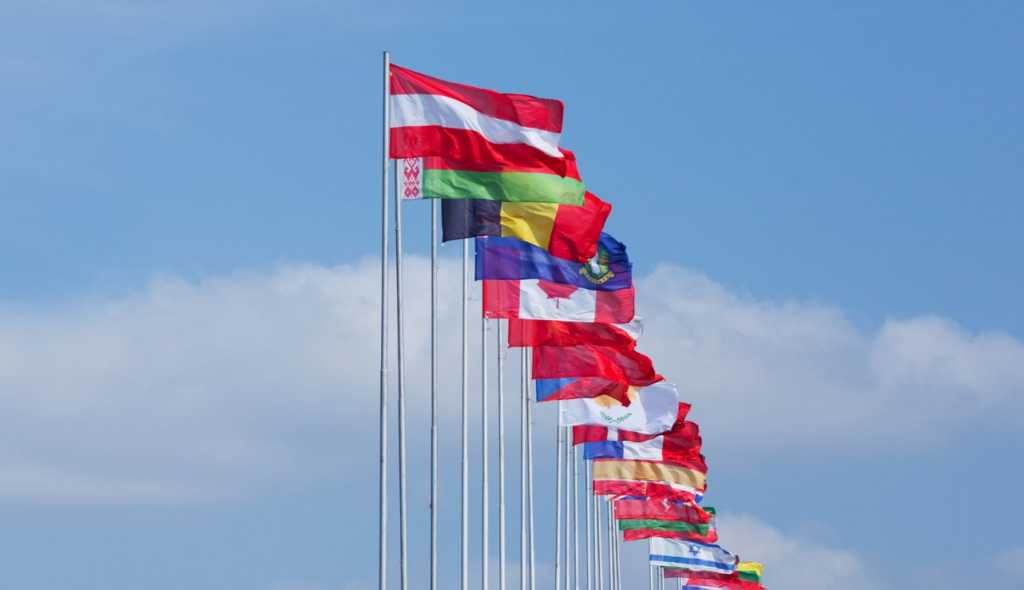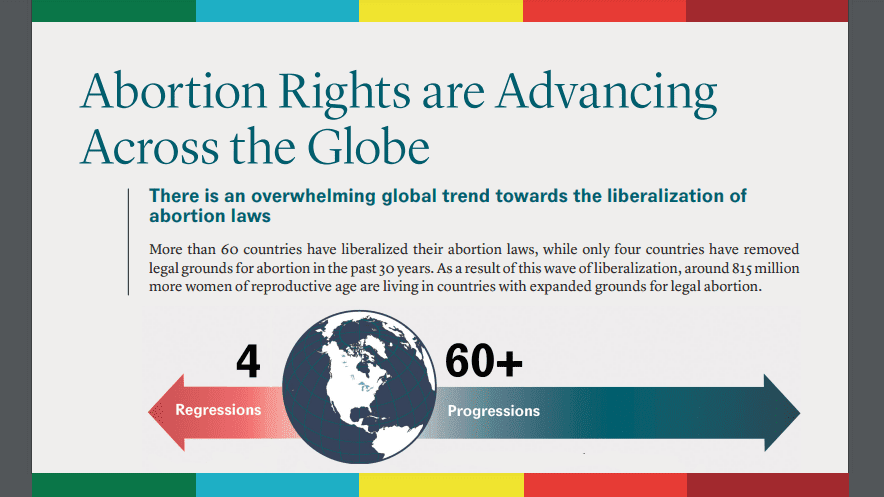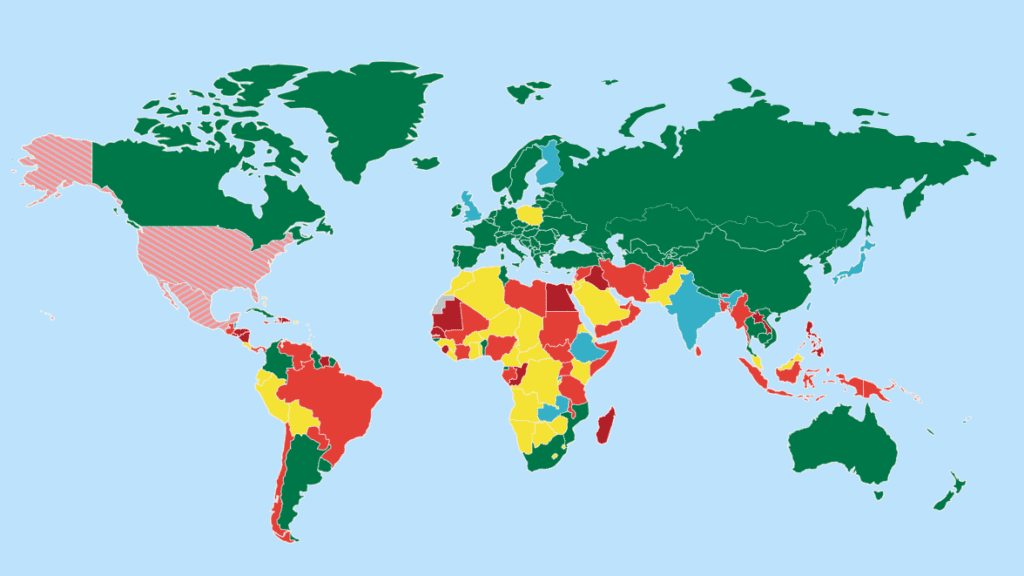
U.S. Abortion Rights in Global Context
U.S.’s Regression on Abortion Rights Makes it a Global Outlier
When the United States Supreme Court eliminated the constitutional right to abortion in 2022, it defied the overwhelming and decades-long global trend towards liberalizing abortion laws and marginalized the U.S. on the international stage.
Since 1994, nearly 60 countries have liberalized their laws on abortion, including 26 countries that have passed legal reforms to permit abortion on request. Conversely, the U.S. is one of only four countries—including El Salvador, Nicaragua, and Poland—that have removed legal grounds for abortion over the same time period.
In recent decades, international human rights bodies and regional and national courts have increasingly found that abortion is necessary to protect the rights to life, health, non-discrimination, information, and privacy, as well as freedom from ill-treatment, harmful practices and gender-based violence. The World Health Organization also recognizes abortion as necessary to the realization of human rights. As such, abortion regression in the U.S. deviates from international trends, human rights, and global public health guidance.
The Center’s fact sheet, “U.S. Abortion Laws in Global Context,” examines global trends in abortion laws, noting how abortion laws being passed in the U.S. are some of the most extreme in the world.
“The restrictive laws being passed in the U.S. are more similar to laws in countries such as Uganda, Tanzania, Brazil, and Guatemala.”
U.S. Abortion Laws in Global Context Fact Sheet, p. 3
I. Abortion Regression in the U.S.
The U.S. Supreme Court’s ruling in Dobbs v. Jackson Women’s Health Organization revoked a fundamental right that Americans relied upon for generations. It eliminated all federal constitutional protections for abortion by overturning the 1973 ruling in Roe v. Wade and cleared the way for states to ban or severely restrict abortion access.
More than a dozen states have banned abortion, and additional states are taking action to do so. These bans often disproportionately impact Americans who are already facing systemic health, racial and economic discrimination.
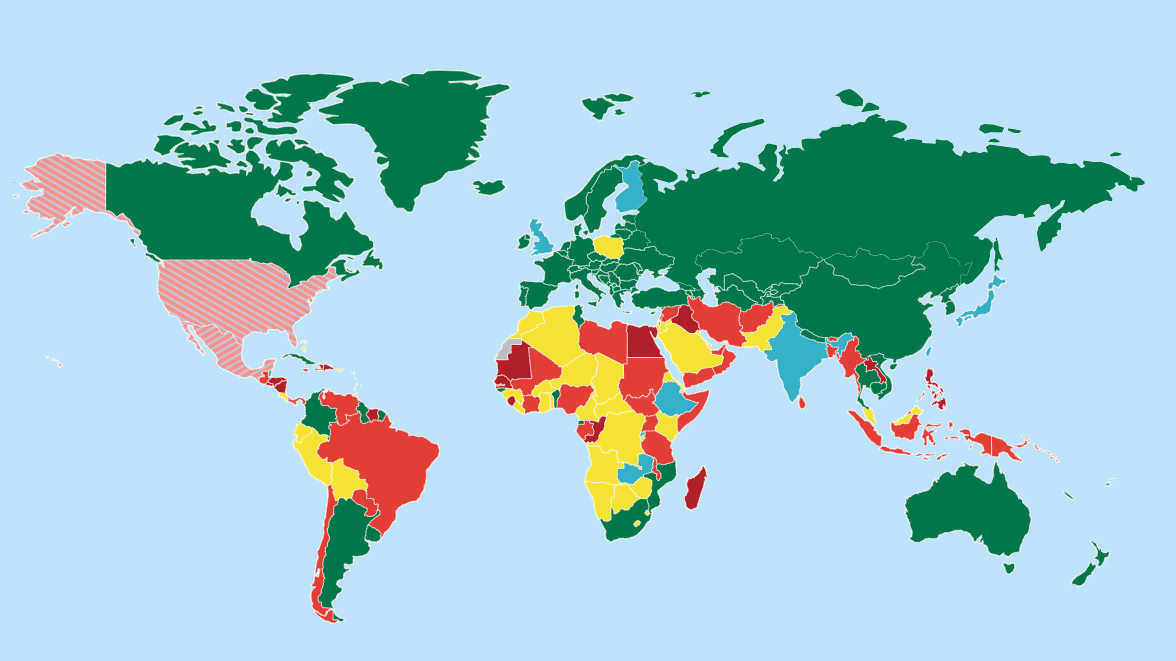
The Supreme Court’s ruling has caused chaos and confusion for patients and providers, as well as a public health emergency across the country. In states where abortion is banned, pregnant people are forced to travel out of state to obtain abortion care—or remain pregnant against their will. Fearful of subjecting themselves or their institutions to legal liability, doctors and hospital staff are reluctant to provide care, even when their patients risk losing their lives, health and fertility.
II. Abortion as an International Human Right
International human rights bodies, as well as regional and national courts, have consistently recognized that abortion is necessary to realize rights to life, health, non-discrimination, information and privacy, as well as freedom from ill-treatment, harmful practices and gender-based violence.
Moreover, numerous United Nations (UN) human rights treaties—including the Convention Against Torture (CAT), the International Covenant on Civil and Political Rights (ICCPR), and the Convention on the Elimination of All Forms of Discrimination Against Women—oblige member states to uphold abortion rights. The UN Human Rights Committee has noted that the ICCPR prohibits member states from passing abortion laws that “jeopardize women’s and girls’ lives, subject them to physical or mental pain or suffering…, discriminate against them or arbitrarily interfere with their privacy.”
The international human rights community has widely condemned U.S. abortion regression as a violation of fundamental rights. Following the U.S. Supreme Court’s decision in Dobbs, UN High Commissioner for Human Rights Michelle Bachelet reaffirmed human rights protections for abortion and denounced the impact that the ruling will have on the fundamental rights of millions of people, especially among those with low incomes or who belong to racial and ethnic minorities.
The UN Committee on the Elimination of Racial Discrimination also noted deep concerns with the ruling in Dobbs and recommended that the U.S. address the disparate impact the decision will have on people of color, Indigenous communities, and those with low incomes.
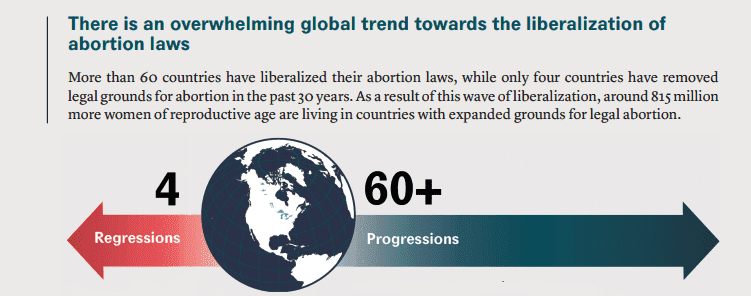
The U.S. is only one of only four countries that has removed legal grounds for abortion. The others are El Salvador, Nicaragua, and Poland.
“Advancements across every region of the world demonstrate increasing recognition that abortion access is essential to health, justice, liberty, and equality.”
Risa Kaufman, Former Director, U.S. Human Rights
III. The Global Trend: Removing Legal Barriers to Abortion Access
As described in “U.S. Abortion Laws in Global Context,” countries in every region of the world have, in recent decades, removed restrictions on abortion and enhanced legal protections for reproductive rights. Below are a few of the highlights in each region.

-
Latin America
Popular movements such as the “Green Wave” have inspired transformative advancements in sexual and reproductive rights, including these critical victories for abortion liberalization:
- -The ruling by Mexico’s highest court to decriminalize abortion nationwide on the federal level in 2023.
- The Colombian Constitutional Court’s landmark ruling in 2022 decriminalizing abortion up to 24 weeks of gestation;
- – The Mexico Supreme Court’s recognition in 2021 of a constitutional right to abortion;
- – Argentina’s 2021 law permitting abortion during the first 14 weeks of pregnancy.
-
Asia and the Pacific
Nepal passed the Safe Motherhood and Reproductive Health Rights Act in 2018, permitting abortion up to 28 weeks of pregnancy under certain conditions. In 2022, India’s Supreme Court ruled that safe and legal abortion under Indian law applies to all women, regardless of marital status. Also in 2022, the Philippine Human Rights Commission recommended that abortion be decriminalized. Countries including South Korea, Thailand and New Zealand have also recently decriminalized abortion or expanded access.
-
Africa
The High Court of Kenya recognized abortion as a fundamental right in 2019; it affirmed that right in 2022 and directed Parliament to enact necessary reforms. In recent years, Uganda, Zambia and Benin have also moved to protect and expand abortion access.
-
Europe
Ireland repealed its constitutional prohibition on abortion in 2018, enabling Irish lawmakers to reform the country’s abortion legislation. Belgium, Cyprus, France, Germany, Gibraltar, Iceland, North Macedonia, the Netherlands, Northern Ireland, and San Marino have also eliminated legal restrictions on abortion in recent years.
“Advancements across every region of the world demonstrate the increasing recognition that abortion access is essential to health, justice, liberty, and equality,” said Risa Kaufman, the Center’s Former Director of U.S. Human Rights. “With the Court’s devastating decision in Dobbs, the United States is out of step with the global trend and with human rights, as support for liberalizing abortion access continues to grow worldwide.”
More information about countries that have liberalized their abortion laws can be found in “U.S. Abortion Laws in Global Context.”
IV. False Claims About the U.S.’s Global Standing Regarding Abortion Laws
Even when compared to relatively restrictive contexts in other countries, the U.S. is an outlier. In many such countries, abortion is still permitted when there is a risk to the pregnant person’s health, which is often defined broadly to encompass mental health and afford providers discretion.
Although some anti-abortion politicians and advocates in the U.S. have compared the country’s post-Dobbs restrictions to European abortion laws, U.S. laws are dramatically discordant with those in Europe. Thirty-seven of the 46 member states in the Council of Europe permit abortion through at least 22 weeks of pregnancy either on request, on broad socioeconomic grounds, or based on the health of the pregnant person. Laws currently being passed in the U.S. more closely resemble restrictions in highly restrictive countries like Uganda, Tanzania, Brazil, and Guatemala.
Human rights experts throughout the world have recognized the harmful effects of the U.S.’s regression on abortion rights. Despite the U.S.’s move backward, countries around the world have responded to the Supreme Court’s ruling by galvanizing support for reproductive rights, removing legal restrictions on abortion, and enhancing legal protections for care.
Center Resources
Explore more about the global context of the U.S.’s regression on abortion with these resources and analyses from the Center. For additional Center resources, publications, and tools addressing reproductive rights and health issues, click here.
Read more on this topic.
-
“Global impacts of Dobbs v. Jackson Women’s Health Organization and abortion regression in the United States,” Sexual and Reproductive Health Matters, 11.16.22
-
“The Myth that America’s Abortion Laws Are More Permissive Than Europe’s,” The Atlantic, 07.22.22
-
“With its Regression on Abortion Rights, the U.S. is a Global Outlier,” Center for Reproductive Rights, 09.09.22
-
Report: “European Abortion Laws: A Comparative Overview,” Center for Reproductive Rights, 10.21.22
-
Video replay: “Progress and Rollbacks: US restrictions on abortion rights in a global context,” session at the International Conference on Family Planning, 11.18.22
-
“After Roe Fell: Abortion Laws by State” Map, Center for Reproductive Rights
-
Report: “Legal Analysis: What Dobbs Got Wrong,” Center for Reproductive Rights, 03.15.23
-
“One Year Later: Dobbs v. Jackson Women’s Health Organization in Global Context,” American Bar Association’s Human Rights Magazine, 07.26.23
In the U.S. and throughout the world, through strategic litigation and policy advocacy, the Center for Reproductive Rights continues to work to advance reproductive rights as fundamental human rights and to fight against laws that restrict reproductive rights and bodily autonomy.
